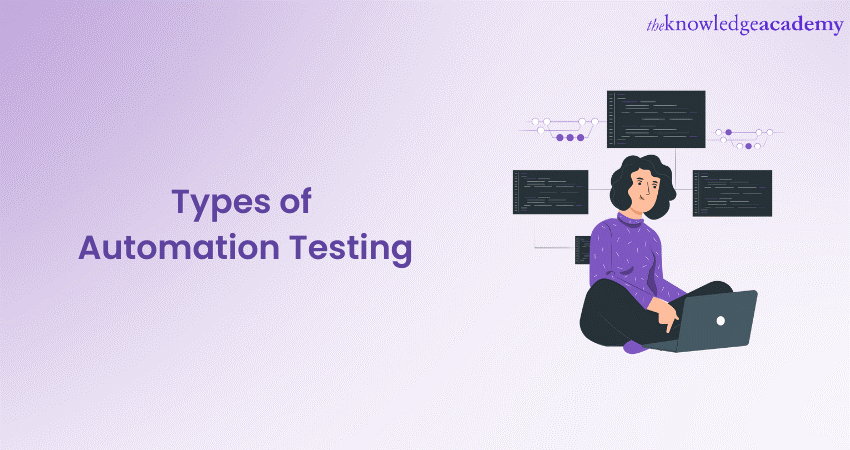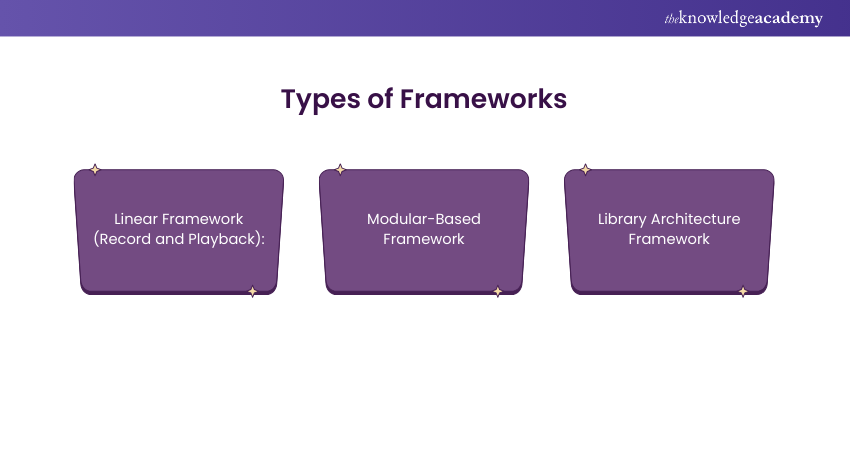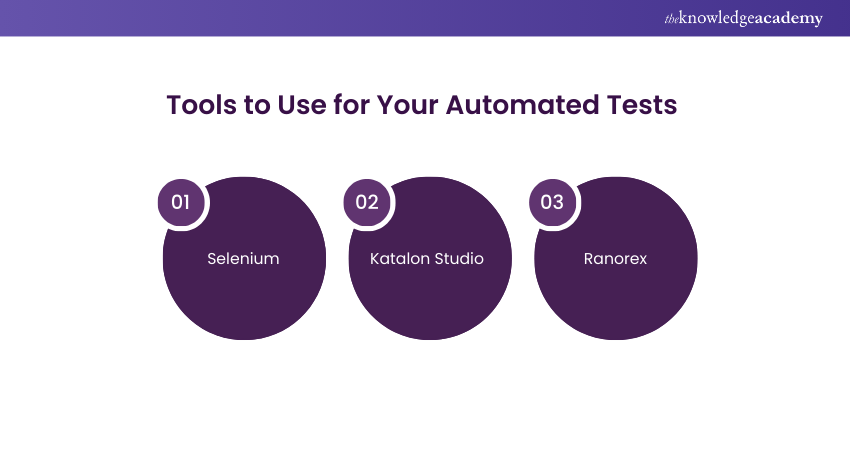We may not have the course you’re looking for. If you enquire or give us a call on +43 720 115337 and speak to our training experts, we may still be able to help with your training requirements.
Training Outcomes Within Your Budget!
We ensure quality, budget-alignment, and timely delivery by our expert instructors.

From functional testing that mirrors real-world scenarios to non-functional testing that challenges your software’s performance, automation testing is like a well-equipped toolbox ready to tackle any challenge. Imagine handing over the repetitive and time-consuming tasks to automated scripts, letting them tirelessly ensure your software runs like a dream. With the right Types of Automation Testing, you can focus on the bigger picture - innovation, creativity, and delivering top-tier experiences to your users.
So, why settle for ordinary when you can automate the extraordinary? Embracing the various Types of Automation Testing means unlocking the potential to build resilient, high-performing applications faster and more efficiently than ever before. Whether you’re just starting your journey or looking to refine your testing strategies, understanding these types is your key to transforming challenges into opportunities.
Table of Contents
1) Why is Test Automation Essential?
2) Different Types of Automation Testing
3) Framework of Automation Test
4) Tools to Use for Your Automated Tests
5) How to Enhance Automation Testing?
6) Conclusion
Why is Test Automation Essential?
Developers are integrating automated Software Testing tools into their workflows to meet customers' expectations. The contemporary Software Development landscape, characterised by continuous development cycles and reliance on external libraries, particularly open-source ones, necessitates the ability to re-run tests each time code is modified.
Different Types of Automation Testing offer a solution by employing Software Testing tools to handle assessments that require frequent repetition or are excessively laborious to conduct manually. Additionally, maintaining accuracy while continuously evaluating new revisions becomes progressively challenging.

Different Types of Automation Testing
Automation Testing encompasses a variety of testing approaches. Each is modified to address specific aspects of software quality assurance. Let's explore the different Types of Automation Testing and gain insights into their significance and applications:

1) UI Testing
UI Testing, or front-end testing, focuses on verifying an application's User Interface (UI). The Testers ensure that all graphical elements, including buttons, menus, and forms, are displayed properly and function as designed. UI automation tools like Selenium and Cypress can simulate user interactions, ensuring that the application's appearance is consistent across different browsers and devices.
2) API Testing
API Testing involves evaluating the functionality and reliability of Application Programming Interfaces (APIs). It aims to verify the communication and data exchange between various software components. Testers assess the API endpoints, request-response formats, and error handling to ensure seamless module integration. Popular tools for API Automation Testing include Postman and Representational State Transfer (REST) Assured.
3) Unit Testing
Unit Testing focuses on testing individual units or components of the application in isolation. It guarantees that each unit functions accurately and according to the required standards. By catching defects early, Unit Testing contributes to quick bug-fixing procedures and overall code stability. Widely used testing frameworks like JUnit for Java and NUnit for the .NET platform help automate unit tests.
4) Integration Testing
Integration Testing checks the compatibility between different app modules. Engineers check and verify the seamless integration of these modules and assess data flow and functionality. This guarantees that the application's elements work harmoniously, minimising integration-related issues. Tools like SOAPUI and Apache JMeter help automate Integration Testing.
5) Functional Testing
Functional Testing checks the compliance of the application's features and functionality with the requirements that have been specified. It involves testing the application from end to end to verify it is working correctly. Some Automation Testing tools, like Selenium and TestComplete, have given Testers the power to perform functional testing efficiently to run many test cases simultaneously.
6) Regression Testing
Regression Testing is important in the Software Development process, especially when code changes or new features are introduced. It involves retesting the application to ensure that recent modifications do not adversely affect existing functionalities. Automation Testing is useful for Regression Testing as it enables the swift execution of previously executed test cases. Selenium and TestNG are commonly used for regression test automation.
7) Performance Testing
Performance Testing evaluates the application's responsiveness, scalability, and stability under varying load conditions. Testers measure response times and resource utilisation to identify potential bottlenecks. They also optimise performance. Automation tools like JMeter and LoadRunner are widely adopted for performance testing automation.
8) Load Testing
Load Testing focuses on assessing an application's performance under expected load conditions. It determines the system's capacity to handle concurrent user traffic without compromising performance. Automated Load Testing with tools like LoadRunner and Apache JMeter helps assess an application's scalability and resilience.
9) Security Testing
Security Testing verifies an application's resistance to potential security threats, providing the protection of sensitive information and safeguarding against potential threats. Automation Testing enables the efficient simulation of different attack scenarios. It also identifies vulnerabilities and potential weaknesses. Tools like OWASP ZAP and Burp Suite support automation for Security Testing.
10) Smoke Testing
Smoke Testing, also known as "Build Verification Testing," is an initial check to ensure the basic functionality of a software build. It verifies critical features. It verifies critical features and helps detect major defects early on. Though it's not a substitute for Comprehensive Testing, successful smoke tests boost confidence in the build's stability for further testing. When conducted in staging or pre-production environments, Smoke Testing saves time and resources and aids in early issue identification.
Non-functional Testing
Non-functional Testing is a crucial aspect of the Software Testing process that primarily focuses on evaluating the attributes of a software application that go beyond its specific functionalities. Unlike functional testing, which verifies if the software performs its intended tasks correctly, non-functional testing assesses the application's performance, usability, security, and other key aspects. These aspects impact the User Experience (UX) and overall quality of the software.
1) End-to-End Testing
End-to-End Testing involves verifying the entire flow of an application, including multiple systems and components. It ensures that all integrated parts work cohesively and meet business requirements. Testers simulate real user scenarios to validate the application's functionality, data integrity, and interactions with external systems.
2) Mobile Testing
Mobile Testing is testing mobile applications to ensure their quality and compatibility with mobile devices, different Operating Systems (OS), and screen sizes. Automation tools like Appium or TestComplete help run test cases on emulators or real devices, determining features such as responsiveness, UI, and touch interactions.
3) Accessibility Testing
Accessibility Testing verifies an app's usability for users with disabilities. It checks the website's compliance with accessibility guidelines, including the Web Content Accessibility Guidelines (WCAG), keyboard navigation, screen reader support, and colour contrast.
4) Cross-browser Testing
Cross-browser Testing verifies whether an application works equally well across different web browsers, ensuring compatibility for a wide range of users. Automation tools like Selenium Grid and BrowserStack can run the tests across different browsers simultaneously.
5) Data-driven Testing
Data-Driven Testing involves executing test cases with various sets of test data. Automation scripts are designed to process different data inputs, helping Testers verify application behaviour under various conditions and uncover potential issues related to data handling.
6) Keyword-driven Testing
Keyword-driven Testing is a scripting approach where Testers use keywords to define test steps and actions, making test cases more readable and easier to maintain. It separates test logic from test data, enhancing reusability and scalability.
7) Configuration Testing
Configuration Testing validates an application's functionality under different configurations, such as different hardware, software, or network settings. It helps identify issues related to specific configurations and ensures consistent performance.
8) Globalisation Testing
Globalisation Testing ensures that an application can adapt to different languages, locales, and cultural settings. It verifies that the application's content, formatting, and date/time representations cater to users worldwide.
9) Localisation Testing
Localisation Testing assesses the accuracy of an application's localisation to specific regions or languages. It ensures that the application displays content in the appropriate language and adheres to local conventions.
Framework of Automation Test
Automation Test frameworks are structured environments or guidelines that help automate the testing process effectively and efficiently. They provide a structured approach for developing, organising, and executing automated tests for various Types of Automation Testing.
A well-designed test automation framework simplifies test creation, maintenance, and reporting, making it an essential component of the Automation Testing process. There are several types of Automation Test frameworks, and selecting the best framework depends on an organisation's specific testing requirements and technologies.
Enroll in our Software Testing Automation Course and boost your testing skills with hands-on learning. Start today!
Types of Frameworks
There are various automation test frameworks available, but here are some of the most common ones:

1) Linear Framework (Record and Playback): This is the simplest framework where testers create and execute individual test scripts for each test case, like recording and playing back a video. Due to its straightforward nature, it’s ideal for small teams and those new to test automation.
2) Modular-Based Framework: This framework breaks down each test case into independent modules, which are managed by a master script. This approach streamlines the workflow and saves time, but it requires careful planning and a strong understanding of test automation.
3) Library Architecture Framework: Expanding on the Modular Framework, this approach groups similar tasks within test scripts into functions, which are stored in a library. These reusable functions can be called upon whenever needed, enhancing flexibility and reusability in testing. However, it requires more scripting effort and greater expertise in test automation.
Tools to Use for Your Automated Tests
When selecting an automation tool to conduct your tests, it’s essential to choose one that fits your specific testing needs. Here are some of the most popular automation testing tools:

1) Selenium
Currently, Selenium is considered the most popular test automation tool for web applications across the globe. It indeed has unparalleled flexibility, being compatible with various programming languages such as C#, Groovy, Java, Perl, PHP, Python, and Scala. As for operating systems (OS), this tool supports Windows, Mac, and Linux. There's also support for operating systems (OS) using macOS and Linux.
2) Katalon Studio
Katalon Studio is an all-inclusive testing solution built on top of Selenium. It provides the capability to test web, API, mobile, and desktop applications-an all-in-one solution. Katalon Studio supports three options to create tests:
a) No-code: Recorded from manual actions by the testers themselves using Record-and-Playback functionality and immediately converting it into an automated test script.
b) Low-code: Out-of-the-box Build-in Keyword libraries are what make different code snippets, which can be used for certain activities with customisable parameters.
c) Full-code: While in the Scripting mode, testers can author their test scripts manually or switch to no-code or low-code mode with just one click.
Katalon offers one workspace for managing testing from planning to writing tests, organising them into suites, running on various environments to comprehensive test reports.
3) Ranorex
Ranorex Studio is ideal for UI testing against desktop, web, and mobile applications. It has a friendly interface that is entirely appropriate for both inexperienced and professional users. Ranorex covers a wide array of technologies and platforms, including .NET, Java, HTML5, Flash, and Flex.
Ranorex smoothly integrates into various development environments and CI/CD pipelines, allowing for continuous testing and fast feedback cycles. Ranorex provides advanced object recognition to ensure robust, reliable tests-even in constantly changing applications. Besides, it allows data-driven testing: testers can execute the very same test with different data sets for broad test coverage.
How to Enhance Automation Testing?
To enhance Automation Testing, two primary strategies are commonly employed:
a) Build Approach: This involves using a test automation framework to develop a bespoke automation solution. It offers the flexibility to tailor the solution to specific requirements, granting complete control over its development, deployment, and upkeep. This self-sufficient testing ecosystem can be scaled as needed. However, it demands significant technical know-how and ongoing script maintenance, which can become increasingly challenging as the system expands.
b) Buy Approach: Alternatively, adopting a third-party vendor’s test automation tool can be advantageous. These commercial tools come equipped with a suite of ready-to-use features, which can significantly reduce development time. They also provide support, comprehensive documentation, and training, which can lessen the reliance on specialised in-house expertise.
Boost your Automation Skills with our Automation Testing Using TestComplete Training. Transform your Testing Approach - Join Today!
Conclusion
Understanding the different Types of Automation Testing is crucial for any organisation aiming to enhance its software quality and accelerate its development cycles. From functional and regression testing to performance and security testing, each type of automation testing plays a unique role in ensuring that applications are robust, reliable, and ready for deployment. By using the correct tools and methodologies, you can automate repetitive tasks, reduce human error, and focus on strategic aspects of software development.
Lead with Application Lifecycle Management. Transform your Approach to Software Development with Application Lifecycle Management Training - Register now.
Frequently Asked Questions

Automation testing methods include unit testing, integration testing, regression testing, smoke testing, performance testing, and security testing. These methods help in verifying software functionality, performance, and security by automating repetitive tasks and reducing manual effort.

The four steps of automation are:
1) Define the scope and select the right test cases for automation;
2) Choose the appropriate automation tools;
3) Develop and execute test scripts;
4) Analyse results and maintain test scripts to ensure accuracy and relevance over time.

The Knowledge Academy takes global learning to new heights, offering over 30,000 online courses across 490+ locations in 220 countries. This expansive reach ensures accessibility and convenience for learners worldwide.
Alongside our diverse Online Course Catalogue, encompassing 17 major categories, we go the extra mile by providing a plethora of free educational Online Resources like News updates, Blogs, videos, webinars, and interview questions. Tailoring learning experiences further, professionals can maximise value with customisable Course Bundles of TKA.

The Knowledge Academy’s Knowledge Pass, a prepaid voucher, adds another layer of flexibility, allowing course bookings over a 12-month period. Join us on a journey where education knows no bounds.

The Knowledge Academy offers various Software Testing Courses, including Unit Testing, Software Testing Black Belt and Software Testing Green Belt courses. These courses cater to different skill levels, providing comprehensive insights into API Automation Testing.
Our Business Analysis Blogs cover a range of topics related to Automation Testing, offering valuable resources, best practices, and industry insights. Whether you are a beginner or looking to advance your knowledge on Software Testing, The Knowledge Academy's diverse courses and informative blogs have you covered
Upcoming Business Analysis Resources Batches & Dates
Date
 ISTQB Software Testing Foundation
ISTQB Software Testing Foundation
Mon 6th Jan 2025
Mon 3rd Feb 2025
Mon 17th Feb 2025
Mon 3rd Mar 2025
Mon 17th Mar 2025
Mon 31st Mar 2025
Mon 28th Apr 2025
Mon 19th May 2025
Mon 2nd Jun 2025
Mon 16th Jun 2025
Mon 30th Jun 2025
Mon 14th Jul 2025
Mon 28th Jul 2025
Mon 11th Aug 2025
Mon 8th Sep 2025
Mon 22nd Sep 2025
Mon 6th Oct 2025
Mon 20th Oct 2025
Mon 3rd Nov 2025
Mon 17th Nov 2025
Mon 1st Dec 2025
Mon 15th Dec 2025







 Top Rated Course
Top Rated Course


 If you wish to make any changes to your course, please
If you wish to make any changes to your course, please


